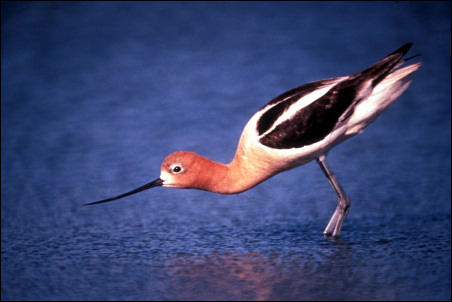
American Avocet
Recurvirostra americana
|
|
Context
Kingdom: Animalia
Phylum: Chordata
Subphylum: Vertebrata
Class: Aves
Order: Charadriiformes
Family: Recurvirostridae
|
 |
American Avocet (Recurvirostra americana) in breeding plumage. Photograph courtesy of U.S. Fish and Wildlife Service. |
Physical Characteristics
Large shorebirds weighing 275-350 g with 28-inch (72-cm) wingspan and about 17-19 inches (43-47 cm) long. Bold distinguishable black and white pattern on back when
wings are in resting position, with long grayish blue legs and a long black upturned bill. Head mostly gray turning rusty color during breeding season, January thru March. The sexes are similar,
but the female is slightly smaller with a shorter and more curved bill. Immature birds also are similar, but the head is a light buff color (Robinson, et al., 1997;Thompson, 2002).
Conservation Status
Recurvirostra americana populations declined in the 1960s and 1970s, largely from the loss of wetlands and habitat fragmentation. They are protected by the U.S.
migratory Bird Act and are making a comeback (Robinson, et al., 1997; Thompson, 2002).
Geographic Range
American Avocets are common in shallow ponds, marshes, lakeshores, and coastal areas. This species breeds in the western Great Plains, along the Atlantic Coast, and also in
central Mexico. It also breeds in isolated wetland areas in the arid western states and along the coasts of California and Texas. The winter range is in California and Mexico, and along coast from
Texas to North Carolina (Robinson, et al., 1997; National Geographic, 1987).
Habitat and Diet
The American Avocet prefers shallow fresh and saltwater wetlands and feeds while wading or swimming, primarily on aquatic insects. Locates food by sight or sweeps its long
open bill from side to side, capturing prey by touch. They also will dive for food like dabbling ducks and are very good swimmers (Robinson, et al., 1997; Thompson, 2002).
Reproductive Characteristics
Even though avocets are monogamous and loosely colonial, they still engage in elaborate courtship rituals. The female will lay 3-4 eggs in each clutch. The
incubation period is 22-28 days. Nests are scrapes, sometimes lined on bare ground or short vegetation near water. The young are precocial, fledging at 28-35 days (Perrins and Middleton, 1985;
Thompson, 2002).
Literature Cited
Robinson, J.A., L.W. Oring, J.P. Skopura, and R. Boettcher. 1997. American Avocet (Recurvirostra americana). In The Birds of North America, no. 275. (A Poole and F.
Gill, eds.). The Academy of Natural Sciences, Philadelphia, and the American Ornithologists' Union, Washington, D.C.
National Geographic Society. 1987. Field Guide to the birds of North America. (3rd ed.) Library of Congress, Washington, D.C.
Perrins C.M., and A.L.A. Middleton (eds.). 1997. The Encyclopedia of Birds. Facts on File Publications, New York.
Thompson, P. 2002. Recurvirostra americana. (On-line) Animal
Diversity Web. Accessed 28 March 2006.
Mike Sealy, March 2006



